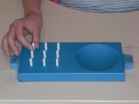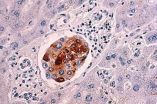(Press-News.org) By using noninvasive stimulation, researchers were able to temporarily improve the ability of people with spinal cord injuries to use their hands. The findings, reported on November 29th in Current Biology, a Cell Press publication, hold promise in treating thousands of people in the United States alone who are partially paralyzed due to spinal cord injury.
"This approach builds on earlier work and highlights the importance of the corticospinal tract—which conducts impulses from the brain's motor cortex to the spinal cord and is a major pathway contributing to voluntary movement—as an important target for intervention after spinal cord injury," said Monica Perez of the University of Pittsburgh.
The researchers tested the new method in 19 people with chronic cervical spinal cord injury and 14 uninjured people. The treatment was customized to each individual and paired transcranial magnetic stimulation delivered to a specific part of the motor cortex with electrical stimulation to peripheral nerves found in the wrist.
One hundred paired pulses were delivered every 10 seconds for a period of around 20 minutes to produce volleys of neural activity. The timing of arrival of those volleys in the spinal cord was absolutely essential to the treatment's success, the report shows.
"This short, noninvasive stimulation protocol has the potential to be used within a clinic setting as part of a rehabilitation technique," said study coauthor Karen Bunday, also of the University of Pittsburgh. "When pulses from the motor cortex were precisely timed to arrive at the spinal cord one or two milliseconds before pulses from the peripheral nerve, we observed an increase in spinal cord transmission and voluntary motor output for up to 80 minutes."
After the noninvasive treatment, the majority of the participants in the study could exert more force with their hand muscles. Those effects translated into greater manual dexterity when participants were asked to grasp and manipulate small pegs with their index fingers and thumbs.
More prolonged use of the technique or its combination with other rehabilitation strategies may well improve its therapeutic benefits, the researchers say. The protocol might also be used in the treatment of other kinds of motor disorders involving damage to the corticospinal tract.
"Human electrophysiology can be a powerful tool for developing therapies," Perez concluded. "We need to explore new targets to improve rehabilitation strategies by taking advantage of our knowledge in human physiology and their mechanisms."
INFORMATION:
Bunday et al.: "Strengthening residual corticospinal-motoneuronal synapses enhances voluntary motor output after human spinal cord injury."
Hand use improved after spinal cord injury with noninvasive stimulation
2012-11-29
ELSE PRESS RELEASES FROM THIS DATE:
Traffic cops of the immune system
2012-11-29
This press release is available in German.
Now, scientists at the Helmholtz Centre for Infection Research (HZI) have looked into the origin of Tregs and uncovered a central role played by the protein IkBNS. Armed with this knowledge, the researchers hope to manipulate Tregs in order to either inhibit or activate the immune system. Biochemist Prof. Ingo Schmitz and his team have now published their findings in the scientific journal Immunity.
The immune system is a complex network of different types of cells and chemical messengers. The regulatory cells and other immune ...
UW-Madison scientists create roadmap to metabolic reprogramming for aging
2012-11-29
MADISON – In efforts to understand what influences life span, cancer and aging, scientists are building roadmaps to navigate and learn about cells at the molecular level.
To survey previously uncharted territory, a team of researchers at UW-Madison created an "atlas" that maps more than 1,500 unique landmarks within mitochondria that could provide clues to the metabolic connections between caloric restriction and aging.
The map, as well as the techniques used to create it, could lead to a better understanding of how cell metabolism is re-wired in some cancers, age-related ...
Study helps resolve debate about how tumors spread
2012-11-29
A team of scientists, led by researchers at the University of California, San Diego School of Medicine, has shown for the first time how cancer cells control the ON/OFF switch of a program used by developing embryos to effectively metastasize in vivo, breaking free and spreading to other parts of the body, where they can proliferate and grow into secondary tumors.
The findings are published in the December 11 issue of the journal Cancer Cell.
In 90 percent of cancer deaths, it is the spreading of cancer, known as metastasis, which ultimately kills the patient by impacting ...
Study sheds light on how pancreatic cancer begins
2012-11-29
A diagnosis of pancreatic cancer is particularly devastating since the prognosis for recovery is usually poor, with the cancer most often not detected until late stages.
Research led by scientists at the University of California, San Diego and UC San Francisco Schools of Medicine examined the tumor-initiating events leading to pancreatic cancer (also called pancreatic ductal adenocarcinoma or PDA) in mice. Their work, published on line November 29 in the journal Cancer Cell, may help in the search for earlier detection methods and treatments.
"Previously, it was believed ...
Short-term exposure to essential oils lowers blood pressure and heart rate
2012-11-29
The scents which permeate our health spas from aromatic essential oils may provide more benefits than just a sense of rest and well-being.
For according to a new study(1) in the European Journal of Preventive Cardiology, the essential oils which form the basis of aromatherapy for stress relief are also reported to have a beneficial effect on heart rate and blood pressure following short-term exposure - and may therefore reduce the risk of cardiovascular disease. However, on the downside, those beneficial effects were reversed when exposure to essential oils lasted more ...
Prenatal exposure to testosterone leads to verbal aggressive behavior
2012-11-29
Washington, DC (November 27, 2012) –A new study in the Journal of Communication links verbal aggression to prenatal testosterone exposure. The lead researcher, at University at Buffalo – The State University of New York, used the 2D:4D measure to predict verbal aggression. This study is the first to use this method to examine prenatal testosterone exposure as a determinant of a communication trait.
Allison Z. Shaw, University at Buffalo – The State University of New York, Michael R. Kotowski, University of Tennessee, and Franklin J. Boster and Timothy R. Levine, Michigan ...
Enzyme inhibition protects against Huntington's disease damage in 2 animal models
2012-11-29
Treatment with a novel agent that inhibits the activity of SIRT2, an enzyme that regulates many important cellular functions, reduced neurological damage, slowed the loss of motor function and extended survival in two animal models of Huntington's disease. The study led by Massachusetts General Hospital (MGH) researchers will appear in the Dec. 27 issue of Cell Reports and is receiving advance online release.
"I believe that the drug efficacy demonstrated in two distinct genetic HD mouse models is quite unique and highly encouraging," says Aleksey Kazantsev, PhD, of ...
Biology behind brain development disorder
2012-11-29
Researchers have defined the gene responsible for a rare developmental disorder in children. The team showed that rare variation in a gene involved in brain development causes the disorder. This is the first time that this gene, UBE3B, has been linked to a disease.
By using a combination of research in mice and sequencing the DNA of four patients with the disorder, the team showed that disruption of this gene causes symptoms including brain abnormalities and reduced growth, highlighting the power of mouse models for understanding the biology behind rare diseases.
"Ubiquitination, ...
When good service means bad behavior
2012-11-29
Economists and professionals praise the merits of competition, as it leads to lower prices and improvements in quality. But in the automobile smog-testing industry, competition can lead to corruption and even public health problems, according to research by USC Marshall School of Business Assistant Professor of Management Victor Bennett.
Bennett, along with colleagues Lamar Pierce of Washington University's Olin School of Business, Jason Snyder at the UCLA Anderson School of Management and Michael W. Toffel of Harvard Business School, found that the structure of the smog-testing ...
Study reinforces safety of whooping cough vaccine for older adults
2012-11-29
PASADENA, Calif., Nov. 29, 2012 – Immunizing older adults with the tetanus-diphtheria-acellular-pertussis vaccine (Tdap) to prevent pertussis (more commonly referred to as whooping cough) was found to be as safe as immunizing them with the tetanus and diphtheria (Td) vaccine, according to a study by Kaiser Permanente published in the journal Clinical Infectious Diseases.
Researchers examined the electronic health records of nearly 120,000 people ages 65 and older at seven U.S. health systems between Jan. 1, 2006 and Dec. 31, 2010. The study looked at a number of medical ...


